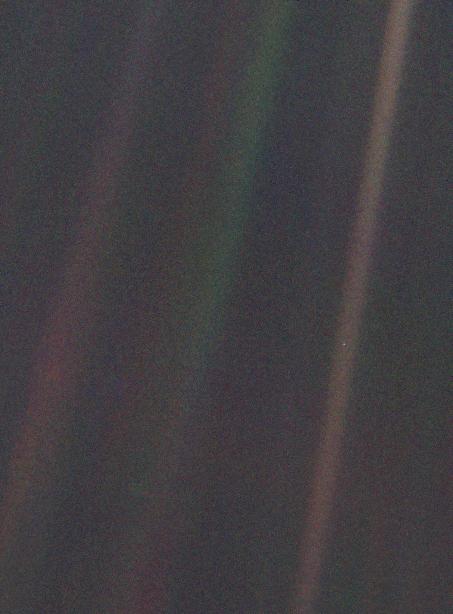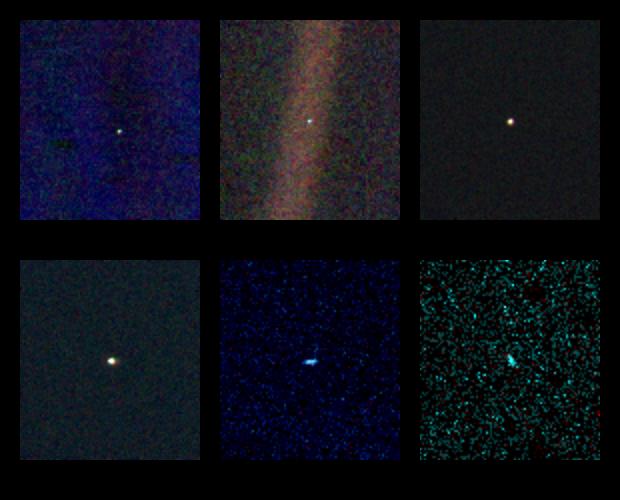It looks like you're using an Ad Blocker.
Please white-list or disable AboveTopSecret.com in your ad-blocking tool.
Thank you.
Some features of ATS will be disabled while you continue to use an ad-blocker.
7
share:
The famous "Pale Blue Dot" image taken from the Voyager 1 spacecraft looking back at its home was taken 25 years ago today (taken February 14,
1990).
 Earth's apparent size is less than a pixel; the planet appears as a tiny dot against the vastness of
space, among bands of sunlight scattered by the camera's optics.
Earth's apparent size is less than a pixel; the planet appears as a tiny dot against the vastness of
space, among bands of sunlight scattered by the camera's optics.
In the above picture, Earth is the pale dot of light about half way up in the brownish band on the right.
In 1990, after Voyager 1 had completed its primary mission, the late astronomer Carl Sagan came up with the idea for Voyager to turn around and take a photograph of Earth across the great expanse of space that was between Voyager and its home starting point, 6 billion kilometers (3.7 billion miles, 40.5 AU) away. Sagan wanted to see an image of the Earth that was only one pixel, to give an indication as to how precarious our existence is, and how precious that existence is.
Carl Sagan talks about the "Pale Blue Dot" in this video. Listening to his words has the really odd effect of making me feel very small, yet somehow very grand at the same time.
He is the poetic narrative from that video, as written by Carl Sagan:
Voyager also took a "family portrait" of the other planets that was visible to it:
 From left to right, top to bottom: Venus, Earth, Jupiter, and Saturn, Uranus, Neptune. Mercury is
too close to the sun to be seen. Mars was not detectable by the Voyager cameras due to scattered sunlight in the optics, and Pluto was not included in
the mosaic because of its small size and distance from the sun.
From left to right, top to bottom: Venus, Earth, Jupiter, and Saturn, Uranus, Neptune. Mercury is
too close to the sun to be seen. Mars was not detectable by the Voyager cameras due to scattered sunlight in the optics, and Pluto was not included in
the mosaic because of its small size and distance from the sun.
Sources:
'Pale Blue Dot' Images Turn 25
Wikipedia -- Pale Blue Dot

In the above picture, Earth is the pale dot of light about half way up in the brownish band on the right.
In 1990, after Voyager 1 had completed its primary mission, the late astronomer Carl Sagan came up with the idea for Voyager to turn around and take a photograph of Earth across the great expanse of space that was between Voyager and its home starting point, 6 billion kilometers (3.7 billion miles, 40.5 AU) away. Sagan wanted to see an image of the Earth that was only one pixel, to give an indication as to how precarious our existence is, and how precious that existence is.
Carl Sagan talks about the "Pale Blue Dot" in this video. Listening to his words has the really odd effect of making me feel very small, yet somehow very grand at the same time.
He is the poetic narrative from that video, as written by Carl Sagan:
From this distant vantage point, the Earth might not seem of any particular interest. But for us, it's different. Consider again that dot. That's here. That's home. That's us. On it everyone you love, everyone you know, everyone you ever heard of, every human being who ever was, lived out their lives. The aggregate of our joy and suffering, thousands of confident religions, ideologies, and economic doctrines, every hunter and forager, every hero and coward, every creator and destroyer of civilization, every king and peasant, every young couple in love, every mother and father, hopeful child, inventor and explorer, every teacher of morals, every corrupt politician, every "superstar," every "supreme leader," every saint and sinner in the history of our species lived there – on a mote of dust suspended in a sunbeam.
The Earth is a very small stage in a vast cosmic arena. Think of the rivers of blood spilled by all those generals and emperors so that in glory and triumph they could become the momentary masters of a fraction of a dot. Think of the endless cruelties visited by the inhabitants of one corner of this pixel on the scarcely distinguishable inhabitants of some other corner. How frequent their misunderstandings, how eager they are to kill one another, how fervent their hatreds. Our posturings, our imagined self-importance, the delusion that we have some privileged position in the universe, are challenged by this point of pale light. Our planet is a lonely speck in the great enveloping cosmic dark. In our obscurity – in all this vastness – there is no hint that help will come from elsewhere to save us from ourselves.
The Earth is the only world known, so far, to harbor life. There is nowhere else, at least in the near future, to which our species could migrate. Visit, yes. Settle, not yet. Like it or not, for the moment, the Earth is where we make our stand. It has been said that astronomy is a humbling and character-building experience. There is perhaps no better demonstration of the folly of human conceits than this distant image of our tiny world. To me, it underscores our responsibility to deal more kindly with one another and to preserve and cherish the pale blue dot, the only home we've ever known.
—Carl Sagan, Pale Blue Dot: A Vision of the Human Future in Space
Voyager also took a "family portrait" of the other planets that was visible to it:

Sources:
'Pale Blue Dot' Images Turn 25
Wikipedia -- Pale Blue Dot
edit on 2/14/2015 by Soylent Green Is People because: (no reason given)
In a digital image made up of pixels, how can something be less than one pixel across?
originally posted by: wildespace
In a digital image made up of pixels, how can something be less than one pixel across?
Good point...But maybe they mean the actual size of Earth compared to the size of the image would be less that one pixel, even though it shows up as an entire pixel in the image.
As you say, if a pixel is the smallest unit in an image, then something in the image cannot appear any smaller than one pixel.
edit on 2/14/2015 by Soylent Green Is People because: (no reason given)
Meh... I thought the same question, but that's prolly why it's not brighter... The pixel, in my guess, isn't Earth, rather the pixel where Earth
is, just a little lighter than it would have been without... Hence the paleness? Idk.
a reply to: wildespace
It is possible, if you take anti-aliasing and blurring into account.
For instance, in a pixel image without blurring, like an NES sprite, every visual data point occupies exactly one pixel. But consider what happens when you scale a photograph down to the scale of an NES sprite... same number of pixels, but significantly more information and visual data points being conveyed through subtle value and color shifts... it is one of the concepts that marked the transition from 80s to early 90s style computer graphics... characters and graphics that move by less than a discrete pixel at a time through subtle blurring effects.
To translate how this concept applies to an astronomical image, data that is less than a pixel width can still appear as very subtle color shifts in the region of the pixels it would have occupied, that our eye reads as blurring. It of course still takes at least a single pixel to be the information carrier, but the object is less than a pixel across in perception.
It is possible, if you take anti-aliasing and blurring into account.
For instance, in a pixel image without blurring, like an NES sprite, every visual data point occupies exactly one pixel. But consider what happens when you scale a photograph down to the scale of an NES sprite... same number of pixels, but significantly more information and visual data points being conveyed through subtle value and color shifts... it is one of the concepts that marked the transition from 80s to early 90s style computer graphics... characters and graphics that move by less than a discrete pixel at a time through subtle blurring effects.
To translate how this concept applies to an astronomical image, data that is less than a pixel width can still appear as very subtle color shifts in the region of the pixels it would have occupied, that our eye reads as blurring. It of course still takes at least a single pixel to be the information carrier, but the object is less than a pixel across in perception.
a reply to: Soylent Green Is People
Yup. A light source does not have to cover an entire pixel in order to cause that pixel to be excited. Just needs to hit it with enough photons.
Good point...But maybe they mean the actual size of Earth compared to the size of the image would be less that one pixel, even though it shows up as an entire pixel in the image.
Yup. A light source does not have to cover an entire pixel in order to cause that pixel to be excited. Just needs to hit it with enough photons.
edit on 2/16/2015 by Phage because: (no reason given)
Reading Carl Sagan's essay on "The pale Blue Dot" always gives me goosebumps...and the video posted in the OP of Carl Sagan's narration of that
essay is even better still. The man not only had a way with words, but he had a way of speaking those words that was so eloquent. Gently spoken, yet
powerfully delivered:
So small yet so grand, indeed.
originally posted by: Soylent Green Is People
Carl Sagan talks about the "Pale Blue Dot" in this video. Listening to his words has the really odd effect of making me feel very small, yet somehow very grand at the same time.
So small yet so grand, indeed.
new topics
-
Cold Blooded Killers on Christmas!! GRRRRrrr!!
Pets: 6 hours ago -
Plane Crash Today --Azerbaijanian E190 passenger jet
Mainstream News: 10 hours ago
top topics
-
Orange County Makes Shoplifting a Felony
Other Current Events: 15 hours ago, 17 flags -
It's Offical Now
US Political Madness: 17 hours ago, 15 flags -
The reason it works is.....
General Chit Chat: 17 hours ago, 8 flags -
Cold Blooded Killers on Christmas!! GRRRRrrr!!
Pets: 6 hours ago, 8 flags -
Plane Crash Today --Azerbaijanian E190 passenger jet
Mainstream News: 10 hours ago, 6 flags
active topics
-
Cold Blooded Killers on Christmas!! GRRRRrrr!!
Pets • 8 • : Flyingclaydisk -
London Christmas Market BANS Word ‘Christmas’
Social Issues and Civil Unrest • 50 • : Connector -
The clotting is not going away latest
Medical Issues & Conspiracies • 15 • : NoCorruptionAllowed -
Plane Crash Today --Azerbaijanian E190 passenger jet
Mainstream News • 13 • : Boomer1947 -
Statements of Intent from Incoming Trump Administration Members - 2025 to 2029.
2024 Elections • 54 • : WeMustCare -
DefCon Teetering on Escalation
World War Three • 51 • : WeMustCare -
-@TH3WH17ERABB17- -Q- ---TIME TO SHOW THE WORLD--- -Part- --44--
Dissecting Disinformation • 3813 • : WeMustCare -
1 Billion dollars
General Entertainment • 13 • : ColeYounger2 -
It's Offical Now
US Political Madness • 15 • : Imhere -
Political Warfare & The Resister Special Forces Underground
Political Ideology • 2 • : NoCorruptionAllowed
7
